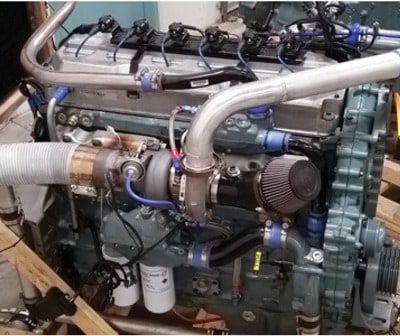Today’s diesel engines have become much more complicated and expensive to maintain. Retrofitting lean burn CNG technology is an economically sound way to get your operation more cost efficient and emissions compliant.
By Evan Williams, Dr. John Reed and Rich Oppman
A lean burn strategy for CNG vehicle engines optimizes vehicle range, fuel cost savings and engine life, without sacrificing performance. Lean burn also allows for the lowest possible CO2 production per mile.
What is Lean Burn Technology?
Lean burn engine and fuel system technology is built from a fueling perspective. In any combustion engine, air is mixed with fuel. A balanced fractional mixture of air and fuel combusted within an engine cylinder is called stoichiometric, or lambda of 1.0. This is how most CNG engines operate in the field, and this allows the use of three-way catalysts.
However, if an engine is operated with an excess of oxygen, combustion temperatures are reduced, NOx emissions are reduced and fuel consumption is reduced. Traditionally, this type of mixture has been more difficult to control than stoichiometric natural gas combustion, so to succeed you have to really carefully tune and calibrate how the engine operates under the various loads and usage profiles. In addition, the selection of ignition systems that provide a high energy spark must be selected in the engine control. In a modern lean burn CNG engine a computerized control unit adjusts the engine’s air to fuel ratio slightly based on the various loads and environmental factors to maintain performance in lean burn status. By rapidly adapting the air to fuel ratio to optimal yet still lean conditions under various engine operating conditions, the engine runs at its highest fuel efficiency and lowest emissions under all operating conditions.
Dollars and Sense
Most times, when you hear about a CNG engine compared to a diesel, you hear two areas where the engine gets degraded from the diesel. One is a 10 to 15 percent reduction in fuel economy and second, the engine does not match the torque curve of the diesel. So not only is fuel economy diminished, but also the vehicle does not perform as well as the original diesel. Advantages of modern Lean Burn technology is that it has equal and sometimes better fuel economy than diesel and, because of how the engine is tuned, the torque curve can be matched to the original diesel, so the driver who has driven this truck as a diesel now experiences the same vehicle performance at greatly reduced noise and vibration levels of the spark-ignited CNG engine. As a bonus, the nasty diesel odor is gone.
For a CNG conversion of a diesel truck, lean burn runs cooler than stoichiometric engine, which means that the engine has less need to rejected heat. Therefore, you don’t have to upsize radiators or mini-converters; you can simply use the same radiator as specified in the diesel prior to conversion.
Maintenance requirements are a little different with lean burn CNG. Spark plugs need to be changed at specified intervals, but oil change intervals are extended over diesels and servicing is eliminated for particulate traps or EGR systems.
Considering This Type of Technology
While a modern lean burn engine doesn’t have a catalyst, they do come with an advanced ignition, as being developed on a NAR Series 60 engine (12.7 liter) (see Figure 1). This ignition system, being developed in conjunction with a major Tier automotive supplier has a very high temperature and short duration spark. This allows an even more complete combustion of fuel resulting in a 20 percent improvement in fuel economy and an 80 percent reduction in NOx emissions compared to stoichiometric. The future version of this engine will also have exhaust gas re-circulation, which further improves emissions, but it also won’t have the problems that the diesel EGR has with clogging by particulate matter; CNG has virtually no particulate. These emissions solutions, combined with other technologies will be used to bring this to the new ultra low NOx emissions levels. Comparing emissions of the ultra low NOx engine to that of electric vehicles, and taking into account the carbon sources used to produce electric power and the availability of renewable natural gas (RNG) at many of the CNG stations, this engine will have a lower overall carbon footprint. Use of RNG results in a net negative carbon output from operating a vehicle with an ultra low NOx engine, so there are real environmental benefits with lean burn CNG at ultra low NOx emissions levels.
A Smart Investment
Lean burn CNG engines can be readily retrofitted into existing in use diesel vehicles right now. If your company has made the investment into natural gas fueling infrastructure, you’ve made a pretty sizable investment. Making that investment economically viable can be more readily achieved by converting your older existing diesels rather than buying new CNG vehicles. By converting your existing fleet vehicles, you reduce the capital outlay to have a CNG fleet, minimize amount of training needed for maintenance personnel and drivers, and your parts and repair supply chains are unchanged. In the near future, there will be retrofit lean burn CNG engines available that are widely used in the waste industry, allowing these fleets to be converted to natural gas with substantially less capital than buying new vehicles. Meanwhile, today’s diesel engines have become much more complicated and expensive to maintain, so retrofitting lean burn CNG technology is an economically sound way to get your operation more cost efficient and emissions compliant. | WA
Evan Williams is Managing Partner of North American Repower.
Dr. John Reed is Chief Administrative Officer of North American Repower.
Rich Oppmann is Chief Operating Officer of North American Repower.
For more information, contact Richard Oppmann at (888) 203-4339 or e-mail [email protected].

